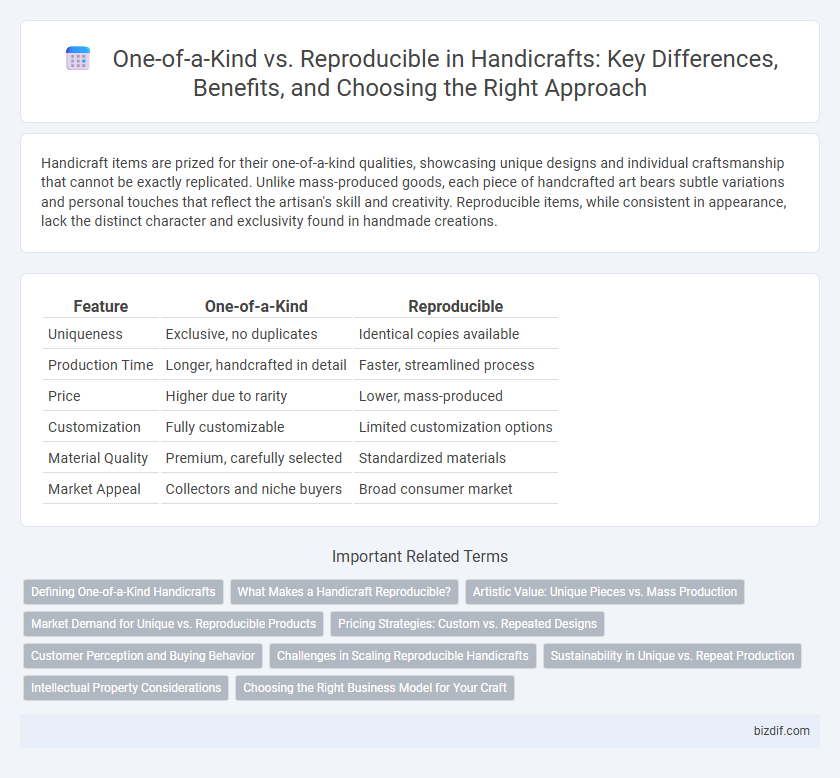Handicraft items are prized for their one-of-a-kind qualities, showcasing unique designs and individual craftsmanship that cannot be exactly replicated. Unlike mass-produced goods, each piece of handcrafted art bears subtle variations and personal touches that reflect the artisan's skill and creativity. Reproducible items, while consistent in appearance, lack the distinct character and exclusivity found in handmade creations.
Table of Comparison
| Feature | One-of-a-Kind | Reproducible |
|---|---|---|
| Uniqueness | Exclusive, no duplicates | Identical copies available |
| Production Time | Longer, handcrafted in detail | Faster, streamlined process |
| Price | Higher due to rarity | Lower, mass-produced |
| Customization | Fully customizable | Limited customization options |
| Material Quality | Premium, carefully selected | Standardized materials |
| Market Appeal | Collectors and niche buyers | Broad consumer market |
Defining One-of-a-Kind Handicrafts
One-of-a-kind handicrafts are unique creations handcrafted with distinct materials, techniques, and artistic expression that cannot be exactly replicated. These artisanal pieces emphasize originality, often showcasing the maker's individual skill and cultural heritage, making each item a singular work of art. Unlike reproducible crafts produced in multiples, one-of-a-kind items carry intrinsic value through their exclusivity and detailed craftsmanship.
What Makes a Handicraft Reproducible?
A handicraft becomes reproducible when artisans use standardized techniques, molds, or templates that allow consistent replication of design and form. Incorporating repeatable processes such as measured carving, controlled dye applications, or patterned stitching ensures uniformity across multiple pieces. Reproducibility is further enhanced by employing tools and materials with predictable properties, maintaining quality control while preserving the handcrafted essence.
Artistic Value: Unique Pieces vs. Mass Production
One-of-a-kind handicraft items possess unparalleled artistic value, showcasing the artisan's individual creativity and intricate skill, making each piece a unique expression of cultural heritage. In contrast, reproducible handicrafts, often produced through mass production techniques, prioritize consistency and affordability but lack the distinctiveness and personal touch inherent in singular creations. Collectors and connoisseurs typically value unique pieces higher due to their rarity, craftsmanship details, and authentic representation of traditional artistry.
Market Demand for Unique vs. Reproducible Products
Market demand for one-of-a-kind handicrafts is driven by consumers seeking exclusive, personalized items that reflect individuality and artistry. In contrast, reproducible products attract buyers prioritizing affordability and consistency, enabling broader accessibility and scalability. Handicraft markets balance these preferences by offering unique pieces for niche collectors and reproducible items for mass consumption.
Pricing Strategies: Custom vs. Repeated Designs
One-of-a-kind handicrafts often command premium pricing due to their uniqueness, craftsmanship, and limited availability. Reproducible designs enable artisans to apply economies of scale, reducing costs per unit and allowing competitive pricing for repeated products. Pricing strategies balance exclusivity and production efficiency, influencing market positioning and customer perception in the handicraft industry.
Customer Perception and Buying Behavior
Customers often perceive one-of-a-kind handicrafts as unique and exclusive, driving higher emotional value and willingness to pay a premium. Reproducible handicrafts attract buyers seeking affordability and consistency, influencing purchasing decisions through availability and price stability. The perceived authenticity of one-of-a-kind items enhances brand loyalty, while reproducible products appeal to mass-market preferences and functional purposes.
Challenges in Scaling Reproducible Handicrafts
Scaling reproducible handicrafts faces challenges such as maintaining consistent quality across multiple units while preserving the artisanal authenticity of each piece. The intricacy of hand techniques often limits mass production, requiring skilled labor and longer production times compared to machine-made goods. Balancing efficiency with craftsmanship demands innovative approaches in training, process standardization, and material sourcing to meet market demand without compromising uniqueness.
Sustainability in Unique vs. Repeat Production
One-of-a-kind handicraft pieces minimize waste by utilizing limited materials and reducing overproduction, promoting sustainable consumption through their exclusivity. Reproducible crafts, while allowing for scalability, often involve standardized processes that can lead to higher resource consumption unless carefully managed with eco-friendly practices. Emphasizing sustainability, artisans can blend unique craftsmanship with responsible repeat production to balance environmental impact and meet consumer demand.
Intellectual Property Considerations
One-of-a-kind handicraft pieces often receive stronger intellectual property protection due to their unique design and originality, making copyright and trademark enforcement more straightforward. Reproducible handicrafts, while easier to manufacture in larger quantities, may face challenges in safeguarding against unauthorized copies because they lack distinctiveness. Understanding the nuances of intellectual property rights, such as design patents and trade dress, is crucial for artisans to protect both individual creations and scalable product lines.
Choosing the Right Business Model for Your Craft
Choosing the right business model for your craft involves weighing the benefits of one-of-a-kind creations against reproducible products tailored for wider audiences. One-of-a-kind handicrafts often command higher prices due to their uniqueness and craftsmanship, attracting collectors and niche markets. Reproducible crafts enable scalable production and consistent quality, making them ideal for steady revenue streams and expanding customer reach.
One-of-a-Kind vs Reproducible Infographic

 bizdif.com
bizdif.com